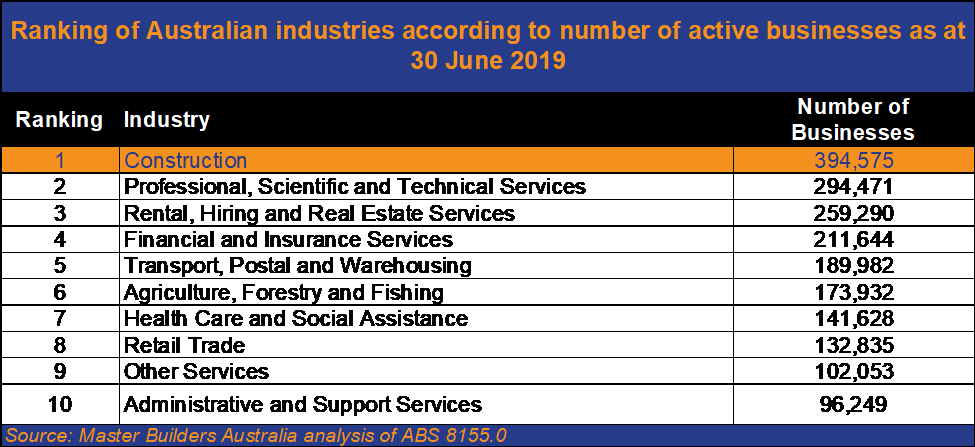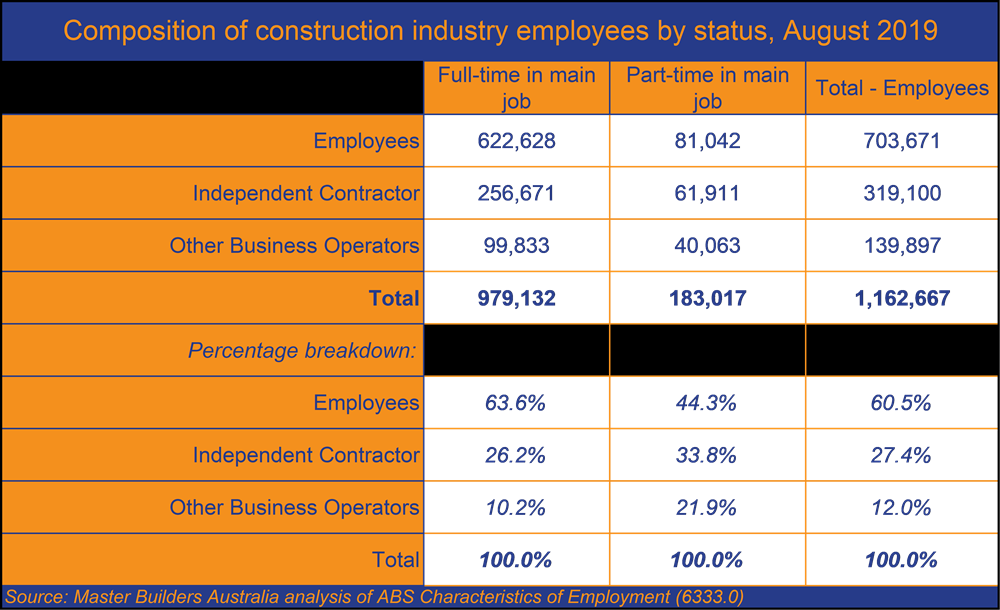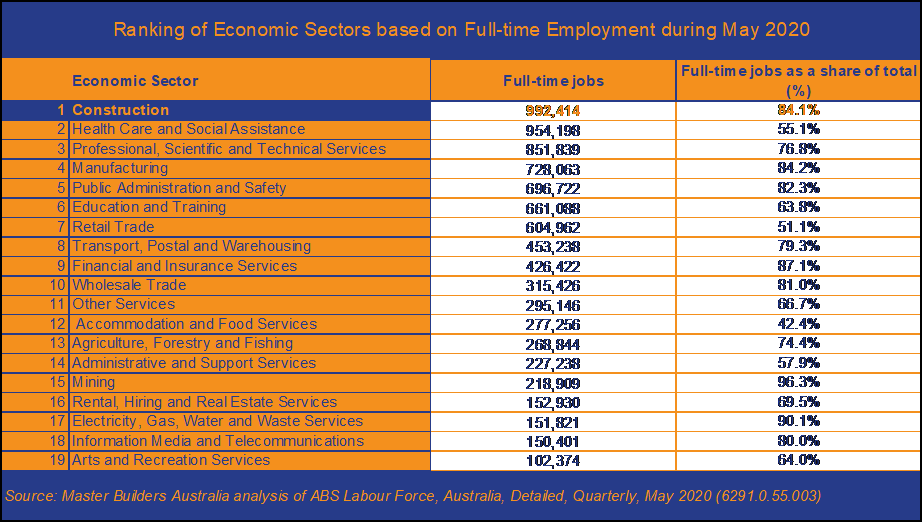- No products in the cart.
_1.jpg)
_1.jpg)
Facts & Stats showcasing the contribution of building & constction to the economy
Collated by Master Builders Australia’s Chief Economist Shane Garrett
Employment & Earnings
- Latest data indicate that 1.18 million Australians are directly employed in the construction industry, equivalent to about 1 in 10 jobs across the economy (9.6% of the total)
- The construction industry supports about 992,000 full-time jobs across the Australian economy, more than any other sector.
- During 2018-19, the value of wages and salaries paid to those working in construction totalled $66.2 billion, a sum larger than every other sector apart from professional services.
- Latest figures for the year to June 2020 indicate that construction employee income totalled $74.6 billion with a further $71.8 billion earned through operating surpluses.
- Full-time jobs account for 84.2% of total construction employment, a much higher share than most other industries.
- Latest data for May 2019, indicate that about 408,000 of those employed in the industry were construction trades workers. These included:
– Carpenters and joiners (142,884 people)
– Plumbers (80,871)
– Painting trades workers (53,237 people)
– Bricklayers and stonemasons (32,326 people)
– Plasterers (31,911 people)
- Unsurprisingly, New South Wales is the state with the largest construction workforce (about 400,000) with Victoria in second place (302,000) and Queensland ranked third (233,600).
- Construction’s share of total employment is highest in New South Wales (10.3%), followed by Western Australia (10.0%) and Queensland (9.8%).
- Of those active in construction, the majority (60.5%) are employees. However, a very substantial number are active as either independent contractors (27.4%) or other business operators (12.0%).
- As well as making up a very significant slice of the current workforce, the construction industry also makes a major contribution to the future supply of labour through apprentice and trainee development.
- During 2019, a total of 19,120 new apprentices and trainees commenced in the construction industry with 11,805 completions over the course of the year.
- At the end of December 2019, a total of 54,550 construction trades apprentices were in still in training.
A very large industry made up of very small businesses
- As well as being the largest provider of full-time jobs, the construction industry also directly supports far more businesses than any other sector of the economy.
- The table below shows that about 395,000 construction businesses were active at the end of June 2019 – about 100,000 more businesses than the next closest sector (professional services).
- The typical construction business is very small in size. Well over one half of construction businesses (59.1%) do not have any employees at all.
- The share of construction businesses which are non-employing is highest in South Australia (67.4%), followed by Western Australia (64.7%) and Victoria (62.0%).
- Small businesses employing fewer than 20 people account for the overwhelming majority (98.5%) of the construction sector.
- In terms of turnover, the majority of construction businesses (56.0%) bring in less than $200,000 annually.
- A sizeable minority of construction businesses (15.5% of the total) operate on less than $50,000 in annual turnover.
- The proportion of construction businesses turning over less than $50,000 per year is highest in Western Australia (17.4%), Victoria (16.4%) and Queensland (15.4%).
Economic value of construction output
- Latest ABS data indicate that the total value of construction work done across Australia was worth $211.3 billion over the year to June 2020.
– Of this, building work was valued at $121.2 billion of which $72.2 billion related to residential building and $49.1 billion in non-residential building
– Engineering construction work done totalled $90.0 billion in value over the year to June 2020.
- The value of construction work done was equivalent to 11.2% of Gross State Product across the eight states and territories during 2018-19. The value of construction work relative to GSP was highest in Victoria (12.7%) during 2018-19, followed by South Australia (11.6%) and New South Wales (11.2%).
- Gross Value Added in the construction industry was estimated at $144.0 billion over the 12 months to June 2020.
- Over the year to March 2020, 196,921 new homes were completed across the country. This is enough new dwelling stock to house 511,000 people.
- Latest figures indicate that an additional 187,835 new homes were still under construction at the end of March 2020.
How construction activity impacts the wider economy
The size and structure of construction activity means that its impact on the wider Australian economy is very considerable.
- During 2018-19, the sales and service income of construction businesses totalled $434.2 billion. A total of $66.2 billion in wages and salaries was paid to those active in construction during 2018-19, a great deal of which was spent and circulated in other areas of the Australian economy like retail, entertainment and tourism.
- Whereas some sectors of the economy have a high dependence on imports, the structure of building and construction work means that it draws in a disproportionately large share of Australian-produced materials and services.
- At the end of June 2019, 23,345 businesses were directly engaged in the manufacture and distribution of building products
- During 2017-18, construction activity generated about $190 billion worth of demand in the sectors of the economy outside of construction:
- Professional services is the sector of the Australian economy which is most dependent on construction activity. During 2017-18, construction activity generated some $23.53 billion worth of demand for this sector, equivalent to 10.4% of its domestic output.
- A large majority (68.4%) of metal manufacturing output is used by the construction sector, equivalent to $17.74 billion worth of the sector’s annual production.
- Sawmill and other wood product manufacturing produces $16.64 billion worth of output annually and practically all of this material is used by the construction industry.
- Overall, 13 sectors of the Australian economy each supply at least $5 billion worth of output to the construction industry annually. As well as those discussed above, these activities also include cement, lime and concrete manufacturing, polymer product manufacturing, and iron/steel manufacturing.
- The economic ripple effect from residential building is particularly strong.
- Research by NHFIC released in mid-2020 estimated that $1 million in residential building output supports about 9 jobs across the economy and generates a total of $2.9 million in economic activity.
Given that residential building activity totalled $72.2 billion over the year to June 2020, NHFIC’s estimates suggest that residential building boosted GDP by $209.3 billion during 2019-20 and sustained 649,500 jobs across the economy.




